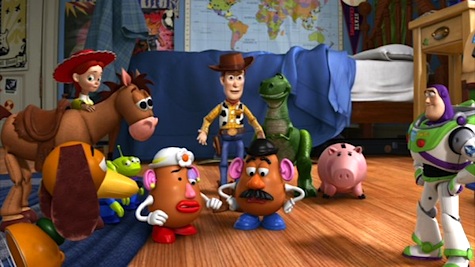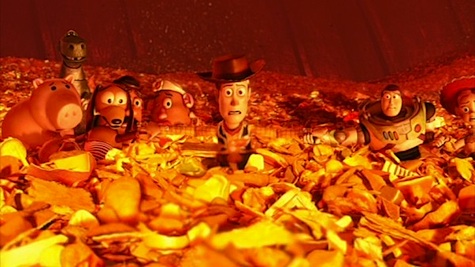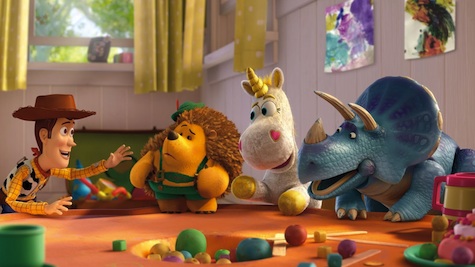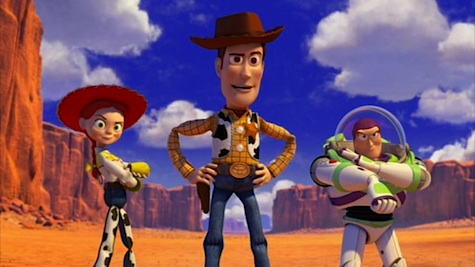But what fascinated Ermengarde most was [Sara’s] fancy about the dolls who walked and talked, and who could do anything they chose when the human beings were out of the room, but who must keep their powers a secret and so flew back to their places “like lightning” when people returned to the room.
“We couldn’t do it,” said Sara, seriously. “You see, it’s a kind of magic.”
—Frances Hodgson Burnett, A Little Princess
It’s an old story, the fancy about toys who come alive when we can’t see, but pretend to be inanimate when humans are around. Hans Christian Andersen takes a turn with it in “The Steadfast Tin Soldier,” and it makes an appearance in the Edwardian melodrama A Little Princess. But it also sits comfortably in a contemporary, computer-and-cell-phone-strewn setting, as in recent books like The Doll People and Toys Go Out, and in the “Toy Story” trilogy.
Usually, the story is about love. Toys, the story goes, live on the love of their owners the way the gods in Neil Gaiman’s American Gods need the worship of human beings. There’s even an Biblical version of the toy story: the legend about Abraham, the first monotheist, who broke most of the idols in his father’s shop, then insisted that the idols had gotten in a fight. When his dad didn’t believe him, Abraham challenged: If they can’t break each other, if they have no power, why do we worship them?
As with gods, so with toys: if their people don’t love them, don’t believe in them, don’t play with them, what are they?
And so Toy Story 3 opens with a spiritual crisis: Andy, the owner of Woody the cowboy and Buzz the astronaut and the whole motley crew we’ve come to know and love in the two previous Toy Story movies, is grown up and packing for college. He hasn’t played with his toys for years—in a regrettable moment, he even refers to them as “junk.” The toys are hurt when they hear this, but even more, they’re terrified about their fate: will they be consigned to the attic? Donated to a daycare center? Or, worst of all, put in the trash?
In the end, as in all good adventure stories, almost everything that could happen does happen: there’s a heartstopping mix-up and the toys are accidentally left at the curb on garbage day, but they flee to Sunnyside daycare center, where they endure abuse, imprisonment, betrayal, and the spectre of the dreaded sandbox. Throughout all their vicissitudes, and despite his friends’ disbelief, the stalwart Woody insists that Andy never meant to throw them out, that he still loves them, that they have to get back to him.

Woody’s body might be plastic, but his heart is true. Over and over, he gives up his own safe position to join his fellow toys: at the movie’s start, when he alone was chosen to accompany Andy to college, he voluntarily leaves the cardboard box to rescue his companions from the curbside. And when he’s found safe haven with Bonnie, a daycare worker’s child, he hitchhikes back to Sunnyside in her backpack so he can help his friends.
In stark contrast to the steadfast Woody, there’s Lotso, a tyrannical villain in the guise of a pink fluffy bear, who smells like strawberries and talks like a folksy television grandpa. Lotso, a bitter nihilist who can’t forgive his former owner for abandoning him at a rest stop during a family car trip, rules over a discontented, dystopian gangland realm at Sunnyside, while Woody leads a tight band of compatriots who have each other’s backs, joining forces to engineer an escape worthy of “The Shawshank Redemption.”
In the movie’s climactic scene, with the toys on the literal brink of destruction, they place their faith in each other, as they all take hands and face their fate together. Love is all they have, and love—plus a timely deus ex machina (or alien ex machina)—turns out to be enough.

But the love that saves them doesn’t come from nowhere: it springs from a shared history, and the history comes from playing together. Play is, famously, the work of childhood, and it’s borne of love: you need to love something to pay that much attention, to turn it into something else in your mind. To make magic. Because imaginative play really is a kind of magic: even small children are mysteriously able to function at a higher developmental level when they’re playing than when they’re doing real-life tasks. And the root of all creative work is play: you could say that play makes the world, or at least that play can make worlds.
It’s clear that the writers behind the Toy Story series know this; after all, imaginative play is their actual livelihood. The brilliant opening scene of Toy Story 3 is a triumphant mashup of the kind of genre juxtapositions—a train robbery! And a speeding car! And a dinosaur! And a horde of monkeys!—that characterize deep play. And then there’s the giddy cascade of visual jokes and riffs: the wobbly tortilla that Mr Potato Head creates to escape from the sandbox; the See ‘n’ Say roulette wheel; the goofy flamboyance of Buzz Lightyear’s Spanish mode.
In the last scene of the movie, Woody’s need to play, and to be played with, trumps even his devotion to Andy, and he joins his friends once more, as Andy bequeaths them to a worthy successor: Bonnie, a preschooler who lives fully in her imagination, a girl whose toys inform Woody that “we do a lot of improv here.”

Andy chokes up when he discovers Woody in the box he’s giving away, and before he says goodbye, he plays with his old toys one last time, joined by Bonnie, in a golden sunlit idyll. It’s the kind of scene that makes adults go all sniffly and verklempt, but even kids can wax nostalgic about the passage of time and the handing down of toys. It’s hard for Andy to let go—it presages the final letting go—but it feels right, to him and to Woody. It’s time.
So, let’s see: mortality, creation, spirituality, love—heady themes for a cartoon about a plastic cowboy with a string in his back. But the old story, the toy story, is sneakier than a snake in your boot: it’ll move and shift and transform when you’re not looking, becoming more alive than you ever realized.
Elisabeth Kushner is a writer and librarian in Vancouver. Her toys would like you to know that they stay right where she puts them; her socks, though, are another story.










